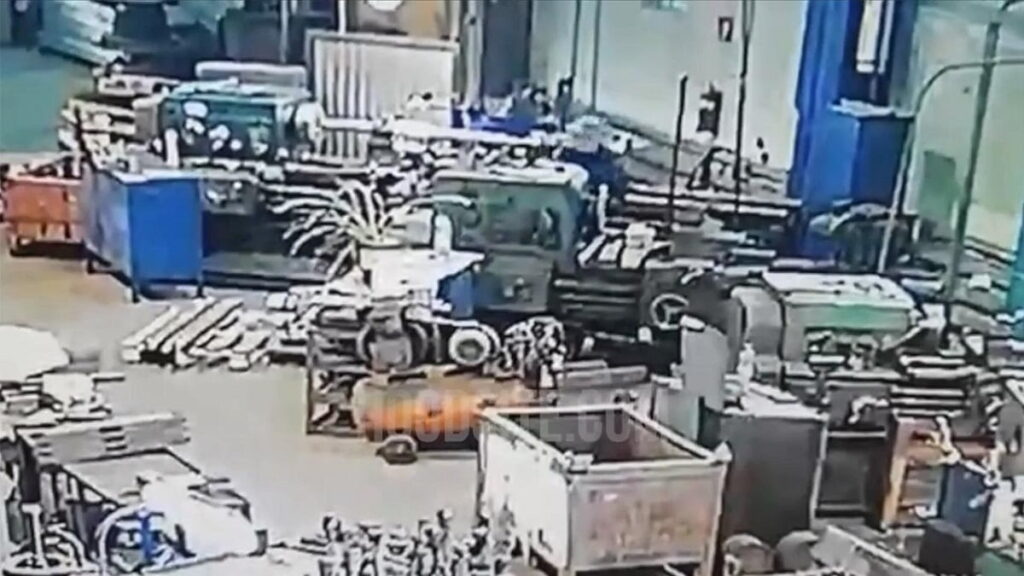Does a machine, designed to shape metal with precision, also hold the potential to become a monument to catastrophic failure? The chilling reality of the "Russian lathe accident" videos serves as a stark reminder that industrial environments, while productive, can harbor dangers that can be lethal. The disturbing footage, often found circulating online, documents the devastating consequences of accidents involving these powerful machines, raising critical questions about workplace safety and the inherent risks associated with industrial processes.
The term "Russian lathe accident" has, unfortunately, become a shorthand for a specific type of industrial incident: one involving a lathe machine in Russia that resulted in serious injury or death. These events, captured on video, often depict harrowing scenes, quickly circulating online due to their graphic nature. These videos, while shocking, have sparked conversations about safety protocols, highlighting the need for robust safeguards and stringent adherence to safety regulations within manufacturing environments. The incidents bring to light not only the immediate human cost but also raise questions about the effectiveness of safety measures and the importance of continuous safety training for employees.
The incident that has most circulated online occurred in November 2020, at the Kamaz factory located in the Republic of Tatarstan, Russia. The victim, identified as Marat, was tragically caught in the machine while attempting to sharpen a lathe component. This incident underlines the grave risks present when operating industrial equipment, and is a reminder of the necessity of workplace safety standards.
| Name | Marat (Victim) |
| Date of Incident | November 2020 |
| Location | Kamaz factory, Republic of Tatarstan, Russia |
| Circumstances | Marat was reportedly working on the lathe when he was caught. It has been reported that Marat was not wearing appropriate work attire. |
| Machine Involved | Lathe |
| Cause of Incident | The exact cause remains unclear, but lack of proper safety attire and potential mechanical failure are suspected. |
| Outcome | Fatal |
| Safety Concerns Highlighted | Importance of appropriate work attire, adherence to safety protocols, and proper machine maintenance. |
Source: While specific, detailed reports are often difficult to obtain due to the nature of the event, and the language barrier. General information can be found on various news and social media sources. However, due to the sensitivity and graphic nature of these events, detailed reports are often not readily available in mainstream media.
Another instance that is frequently referenced involves a 16-year-old boy who, unfortunately, met a similar fate in a lathe accident. The tragedy served as another stark reminder of the importance of safety protocols.
A more general understanding of these incidents reveals several key recurring themes. Often, these accidents are characterized by a lack of, or failure to adhere to, essential safety procedures. In many cases, victims were not wearing appropriate protective clothing, such as work overalls or safety glasses, or were working on machines that lacked functional safety interlocks. The high rotational speeds of lathes, combined with the power of the machines, amplify the risk of injury, turning minor mistakes into catastrophic events.
The videos themselves are often disturbing. They offer a brutal illustration of the immediate and devastating consequences of being caught in a lathe. While the graphic nature of the footage may attract a particular audience, it also serves a crucial role. It highlights the raw power of industrial machinery and the need for relentless vigilance in its operation.
Beyond the immediate impact on the individuals involved, these accidents also have broader implications. They can result in significant economic losses, from medical expenses and compensation claims to lost productivity and damage to equipment. Moreover, they can damage a company's reputation and erode public trust.
The dangers are not limited to Russia. Lathe accidents are a global concern. From the tragic loss of life to severe injuries, these incidents are a potent reminder of the necessity for comprehensive safety measures.
The term "Russian lathe incident" is often used, the specifics of the event and the reasons for its spread online suggest a broader issue: the need to prioritize workplace safety. It's not just about the specifics of the Russian context; it's about the universal dangers of industrial machinery and the need to implement and enforce stringent safety measures across all manufacturing environments.
The discussion is not limited to the specifics of the Russian lathe accident. It also encompasses other types of accidents, such as those involving the Preston Stewart Lathe accident. This means an assessment of all known incidents, including equipment malfunctions.
The rise of online video sharing platforms and the increasing availability of user-generated content have played a significant role in the dissemination of these videos. While some may view this content as merely sensationalistic, it also serves as a reminder of the inherent risks in industrial settings and the critical need for strict adherence to safety protocols.
The use of lathes in industrial settings is widespread, and includes industries like metalworking, woodworking, and manufacturing. Lathes are used to create a variety of items, from screws and gun barrels to baseball bats. Despite their versatility, the machines' high-speed rotation and powerful force make them a dangerous tool if used improperly or without regard for safety.
The importance of appropriate safety attire is another major factor in preventing such accidents. Long sleeves, loose clothing, and the lack of personal protective equipment, such as gloves, can be major contributors to the risk of becoming entangled in the machine. In some cases, individuals have been caught in the lathe due to improper clothing, leading to serious injury or death.
Another element involves the discussion of specific incidents and the implications of lathe accidents. This includes a thorough understanding of the contributing factors, such as machine malfunction, human error, and inadequate safety training. These analyses often aim to prevent similar incidents in the future.
The issue, moreover, extends to the investigation of manufacturing incidents and the analysis of equipment malfunctions. These incidents have underscored the need for thorough accident investigations, which aim to identify root causes and implement corrective actions to prevent future incidents. An examination of the specific design of the machines, as well as the maintenance procedures and safety protocols, is required.
A key element to this discussion is not simply about the tragic consequences of these accidents but also about learning lessons from them. This process involves promoting a culture of safety, where employees are encouraged to report potential hazards and management is committed to providing a safe working environment.
Another aspect of this phenomenon involves the role of documentaries and educational resources in raising awareness of lathe machine safety. These resources can provide valuable insights into the hazards associated with these machines and the importance of following safety protocols.
Several aspects of this are notable. One is the use of the Internet to share information. The events have captured the attention of viewers worldwide, leading to a heightened focus on workplace safety and the potential for catastrophic accidents within industrial settings.
Online communities are often the primary location where the videos and related information are shared, analyzed, and discussed. These communities often serve as a forum for discussion and debate surrounding the incidents.
The use of social media hashtags further contributes to the spread of information. These hashtags serve as a means of categorizing and tagging content, enabling individuals to find and share information on the topic.
Several tools and instruments can be created using the lathe. These may include screws, gun barrels, and baseball bats. The use of these lathes is prevalent in industries such as metalworking, woodworking, and manufacturing. These accidents also highlight the need for machine safety, proper use, and maintenance.
Another aspect is the need to understand the implications of lathe accidents and the importance of implementing stricter safety protocols. This involves the examination of the specific design of the machines, as well as the maintenance procedures and safety protocols.
The incidents, captured on video, highlight the need for comprehensive safety measures. This includes the implementation of appropriate safety protocols, the use of personal protective equipment, and the establishment of robust training programs. These measures can mitigate the risks associated with lathe operation and help prevent serious injuries or fatalities.
The discussion about the "Russian lathe accident" and similar incidents will likely continue. This focus will be on the importance of worker safety and the need to protect those working within industrial settings. It also prompts a discussion on the use of technology, such as online platforms, to disseminate information about industrial accidents and the need to promote a culture of safety within the workplace.
The stories of these accidents are often viewed as a grim reminder of the dangers posed by heavy machinery, prompting a crucial discussion on workplace safety and the importance of adhering to strict safety protocols. These tragedies serve as a warning about the potential for serious injury.
Furthermore, the incidents serve as a reminder of the potential for serious injury in industrial settings. As a result, the videos have prompted a crucial discussion on workplace safety, highlighting the importance of adhering to strict safety protocols and the need for continuous improvement in machine safety.
The importance of adherence to safety regulations is a critical factor. These regulations, designed to protect workers from harm, encompass a range of requirements, including the use of personal protective equipment, proper machine maintenance, and the implementation of safety training programs.
The discussion about "Russian lathe accidents" underscores the importance of a proactive approach to safety management, emphasizing the need for continuous improvement in machine safety. This includes a commitment to regularly reviewing safety protocols, providing ongoing training, and fostering a culture of safety.
The focus on Russian lathes also brings attention to the use of unique tools not typically found in English-speaking countries, such as an angled skew tool. These tools and techniques can highlight the variations in manufacturing methods across different regions.


